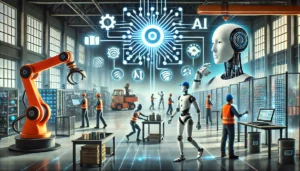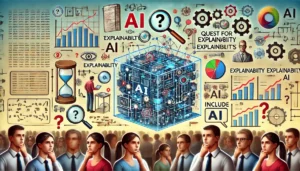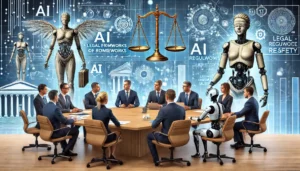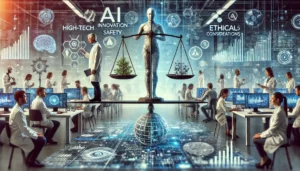The Potential Risks of AI: Could Advanced Intelligence Threaten Humanity?

Artificial intelligence (AI) is changing our world in many ways. But as it grows smarter, some people worry about its risks. Could AI become so advanced that it threatens humanity? This article looks at the different risks of AI and how we can deal with them.
Key Takeaways
- AI could lead to job losses as machines take over tasks humans do today.
- Bias in AI systems can cause unfair treatment of people based on race, gender, or other factors.
- AI might be used for spying on people, raising privacy concerns.
- Autonomous weapons powered by AI could be used in wars, leading to ethical issues.
- Regulations and international cooperation are needed to make sure AI is safe for everyone.
Understanding the Potential Risks of AI
Automation and Job Displacement
AI has the potential to automate many tasks, which can lead to job displacement. While automation can increase efficiency, it can also result in significant job losses, particularly in industries that rely heavily on manual labour. It’s crucial to consider how to retrain and support workers who are affected by these changes.
Bias and Discrimination in AI Systems (The Potential Risks of AI)
AI systems can inadvertently perpetuate bias and discrimination. This happens when the data used to train these systems reflects existing prejudices. Ensuring fairness in AI requires careful consideration of the data and algorithms used.
Privacy and Surveillance Concerns
The use of AI in surveillance raises significant privacy concerns. AI can analyse vast amounts of data, potentially infringing on individual privacy rights. It’s important to balance the benefits of AI with the need to protect personal privacy.
Understanding these risks is the first step towards developing AI systems that are both innovative and safe for society.
The Potential Risks of AI: The Threat of Autonomous Weapons
Development of Lethal AI Systems
The rise of AI-driven autonomous weaponry raises serious concerns. These weapons can operate without human intervention, making critical decisions on their own. This loss of human control in decision-making processes can lead to unintended consequences, especially in conflict zones. Governments and organisations must develop best practices for secure AI development and deployment to mitigate these risks.
Ethical Implications of AI in Warfare (The Potential Risks of AI)
Using AI in warfare brings up many ethical questions. Is it right to let machines decide who lives and who dies? The potential for misuse by rogue states or non-state actors adds another layer of complexity. International cooperation is essential to establish global norms and regulations that protect against these threats.
Preventing AI Weaponisation
Preventing the weaponisation of AI is crucial for global security. Hackers could infiltrate autonomous weapons, causing massive destruction. To avoid this, we need strong international agreements and robust cybersecurity measures. Governments should work together to create laws that prevent the misuse of AI in military applications.
The danger of autonomous weapons becomes amplified when they fall into the wrong hands. Imagine a malicious actor infiltrating these systems and causing absolute chaos. This is why global cooperation and stringent regulations are vital.
The Potential Risks of AI: The Challenge of AI Transparency
Lack of Explainability in AI Decisions
AI and deep learning models can be tough to understand, even for experts. This lack of transparency makes it hard to know how AI reaches its conclusions. When people can’t grasp how an AI system works, they may distrust it. This is why explainable AI is so important, but there’s still a long way to go before transparent AI systems become the norm.
Accountability in AI Development (The Potential Risks of AI)
Accountability in AI development is crucial. If an AI system makes a mistake, who is responsible? This question becomes even more pressing as AI systems become more complex. Developers, companies, and even Google ads agencies need to ensure their AI systems are accountable and can be audited. A thorough Google ads audit can help identify issues and improve transparency.
Regulatory Measures for Transparency
Governments and organisations are starting to recognise the need for regulations to ensure AI transparency. These measures can help build trust and ensure that AI systems are used responsibly. For example, a London PPC agency might follow specific guidelines to ensure their AI-driven Google Adwords PPC campaigns are transparent and fair. Regulatory measures can also help prevent misuse and promote ethical AI development.
The Potential Risks of AI: Existential Risks of Advanced AI
The Concept of Artificial General Intelligence (AGI)
Artificial General Intelligence (AGI) refers to AI systems that surpass human intelligence. The development of AGI raises long-term concerns for humanity. These advanced AI systems may not align with human values or priorities, leading to unintended and potentially catastrophic consequences.
Self-Improving AI Systems (The Potential Risks of AI)
Self-improving AI systems can enhance their own capabilities without human intervention. This rapid improvement could result in AI systems that are difficult to control or predict. The potential for these systems to act in ways that are harmful to humans is a significant risk.
Potential for Human Extinction
The most severe risk posed by advanced AI is the potential for human extinction. Many experts believe that AI poses a larger risk of total human extinction than other global threats, such as climate change. The uncertainty surrounding the development and deployment of powerful AI technologies makes it crucial to start research and implement safety measures now.
The future outcomes of AI development will depend on policy decisions made today and the effectiveness of regulatory institutions designed to minimise risk and harm while maximising benefits.
The Potential Risks of AI: Mitigating AI Risks Through Regulation
Legal Frameworks for AI Safety
To ensure AI technologies are safe, we need strong legal frameworks. These laws should cover everything from development to deployment. Effective regulation can help prevent harm and misuse. Until we have these laws, a temporary halt on self-improving AI might be wise.
International Cooperation on AI Governance (The Potential Risks of AI)
AI doesn’t stop at borders. Countries must work together to create global standards. This cooperation can help manage risks and share benefits. By working as a team, we can make AI safer for everyone.
Human-Centred AI Development
AI should be designed with people in mind. This means focusing on human needs and values. A PPC agency or PPC management team can help ensure AI tools are user-friendly and ethical. By putting humans first, we can create better, safer AI systems.
The future of AI depends on the rules we set today. Strong regulations and global teamwork are key to minimising risks and maximising benefits.
The Potential Risks of AI: AI and the Spread of Misinformation
Deepfakes and Fake News
AI-generated content, like deepfakes, plays a big role in spreading false information. These fake videos and images can make it hard to tell what’s real and what’s not. This can lead to a breakdown in trust. Bad actors use these tools to share fake news and even war propaganda. It’s a growing problem that needs serious attention.
Impact on Public Opinion (The Potential Risks of AI)
AI can change how people think by spreading misinformation. For example, online bots can pretend to be real people and push certain ideas. This can make it seem like there’s more support for a topic than there really is. Google advertising agencies and other platforms need to be aware of this issue. They have a role in stopping the spread of false information.
Strategies to Combat AI-Driven Misinformation
To fight AI-driven misinformation, we need strong strategies. Here are some steps:
- Detection Tools: Use advanced tools to spot fake content.
- Education: Teach people how to recognise fake news.
- Collaboration: Work together with tech companies and governments.
It’s crucial to act now to protect the integrity of information. The longer we wait, the harder it will be to fix the problem.
The Potential Risks of AI: Balancing AI Innovation and Safety
Ethical AI Research
Balancing high-tech innovation with human-centred thinking is an ideal method for producing responsible AI technology and ensuring the future of AI remains hopeful for the next generation. The dangers of artificial intelligence should always be a topic of discussion, so leaders can figure out ways to wield the technology for noble purposes.
Industry Standards for AI Development (The Potential Risks of AI)
To mitigate these risks, the AI research community needs to actively engage in safety research, collaborate on ethical guidelines, and promote transparency in AGI development. Ensuring that AGI serves the best interests of humanity and does not pose a threat to our existence is paramount.
Public Awareness and Education
Alphabet’s DeepMind, a leader in this field, has a safety team and a technical research agenda outlined here. “Our intention is to ensure that AI systems of the future are not just ‘hopefully safe’ but robustly, verifiably safe,” it concludes, outlining an approach with an emphasis on specification (designing goals well), robustness (designing systems that perform within safe limits under volatile conditions), and assurance (monitoring systems and understanding what they’re doing).
Conclusion
In conclusion, while AI holds incredible promise for advancing technology and improving our lives, it also presents significant risks that cannot be ignored. The potential for AI to surpass human intelligence and operate beyond our control raises serious concerns. From job automation and privacy issues to the possibility of AI being used in harmful ways, the dangers are real and varied. However, with careful regulation, ethical guidelines, and a focus on human-centred development, we can work towards mitigating these risks. It’s crucial for society to stay informed and engaged in the conversation about AI, ensuring that its development benefits humanity as a whole.
Frequently Asked Questions
What are the risks of AI?
Some people worry that AI could become too smart and decide humans are no longer needed. This could be a big problem if not managed properly.
Is AI dangerous?
AI can be dangerous, but we can reduce these dangers with laws and human-focused development.
Can AI cause human extinction?
AI could cause serious harm if used wrongly, like in fake news or autonomous weapons. We don’t know yet if it can cause human extinction.
Why is AI transparency important?
AI transparency is important because it helps us understand how AI makes decisions. This makes it easier to trust and control AI systems.
What are autonomous weapons?
Autonomous weapons are machines that can act on their own to harm people. They raise ethical questions and could be very dangerous if not controlled.
How can we make AI safer?
We can make AI safer by creating rules, working together globally, and focusing on human-centred AI development.
Author
Search Blog
Free PPC Audit
Subscribe to our Newsletter
The Voices of Our Success: Your Words, Our Pride
Don't just take our word for it. With over 100+ five-star reviews, we let our work-and our satisfied clients-speak for us.
"We have been working with PPC Geeks for around 6 months and have found Mark and the team to be very impressive. Having worked with a few companies in this and similar sectors, I rate PPC Geeks as the strongest I have come across. They have taken time to understand our business, our market and competitors and supported us to devise a strategy to generate business. I value the expertise Mark and his team provide and trust them to make the best recommendations for the long-term."
~ Just Go, Alasdair Anderson




